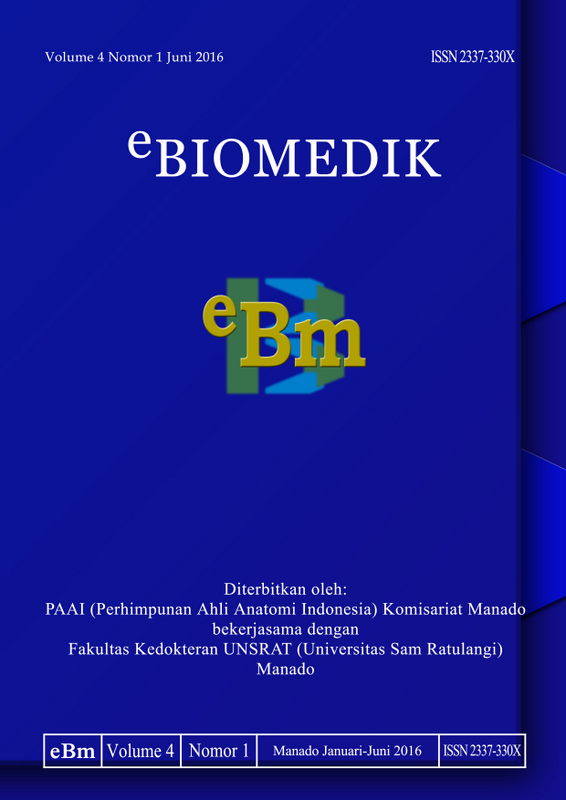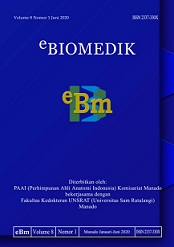POTENSI PENYEBARAN INFEKSI NOSOKOMIAL DI RUANGAN INSTALASI RAWAT INAP KHUSUS TUBERKULOSIS (IRINA C5) BLU RSUP PROF. DR. R. D. KANDOU MANADO
DOI:
https://doi.org/10.35790/ebm.v4i1.11247Abstract
Abstract: Hospital is a patient service with a wide variety of different diseases. Among them are due to infectious diseases, ranging from mild to severe. This can cause a risk of transmission of infection from one patient to another, as well as with health workers who are often exposed to infectious agents. Patients with TB cases are patients with a weak immune system and also the hospitalized patients potentially exposed to nosocomial infections, it is because the patient's condition was very weak and the risk of transmission of infection is compounded when it occurs among patients. This causes pathogenic microorganisms become pathogenic. Necessary research or clinical testing in the laboratory to find out whether in a special installation space inpatient tuberculosis (IRINA C5) has a potential source of transmission of nosocomial infections. The aim of this study was to determine the source and the micro organisms that could potentially lead to the transmission of nosocomial infections in the department of Prof. IRINA C5 BLU Dr. R. D. Kandou. This study uses a prospective descriptive study. The samples studied are floor and wall treatment rooms, indoor furniture, medical equipment and the air in the department of Prof. IRINA C5 BLU Dr. RD Kandou Manado as many as 30 samples and swabs taken. The identification is done with the culture medium. On the results of the study showed 10 samples Bacillus subtilis (33.4%), Lactobacillus sp 7 samples (23.4%), Enterobacter agglomerans 2 samples (6.7%), Serratia liquefaciens 2 samples (6.7%), coccus gram negativ 2 samples (6.7%), Staphylococcus albus 1 sample (3.4%), Staphylococcus sp 1 sample (3.4%), Enterobacter hafniae 1 sample (3.4%), Streptococcus sp 1 sample (3, 4%). The conclusion of this research found most types of bacteria is Bacillus subtilis.
Keywords: Nosocomial infection, IRINA C5, bacteria
Abstrak: Rumah Sakit merupakan tempat pelayanan pasien dengan berbagai macam penyakit yang berbeda-beda. Diantaranya merupakan penyakit karena infeksi, mulai dari ringan sampai berat. Hal ini dapat menyebabkan resiko penularan infeksi dari satu pasien ke pasien yang lainnya, begitupun dengan petugas kesehatan yang sering terpapar dengan agen infeksi. Pasien dengan kasus TBC merupakan pasien dengan daya tahan tubuh yang lemah dan juga menjadi pasien rawat inap yang berpotensi terkena penyakit infeksi nosokomial, hal ini disebabkan karena kondisi pasien yang sangat lemah dan resiko diperparah ketika terjadi penularan infeksi antar pasien. Hal ini menyebabkan mikroorganisme yang tidak patogen menjadi patogen. Diperlukan penelitian atau pengujian secara klinis di laboratorium untuk mengetahui apakah di ruang instalasi rawat inap khusus tuberkulosis (irina C5) mempunyai potensi sumber penularan infeksi nosokomial. Tujuan dari penelitian ini adalah untuk mengetahui sumber dan mikroorganisme yang berpotensi menyebabkan penularan infeksi nosokomial di IRINA C5 BLU RSUP Prof. Dr. R. D. Kandou. Penelitian ini menggunakan metode penelitian deskriptif prospektif. Sampel yang diteliti adalah lantai dan dinding ruang perawatan, perabotan ruangan, peralatan medis dan udara di IRINA C5 BLU RSUP Prof. Dr. R. D. Kandou Manado sebanyak 30 sampel dan diambil secara usapan. Identifikasi dilakukan dengan media kultur. Pada hasil penelitian menunjukkan Bacillus subtilis 10 sampe (33,4%), Lactobacillus sp 7 sampel (23,4%), Enterobacter agglomerans 2 sampel (6,7%), Serratia liquefaciens 2 sampel (6,7%), Kokus gram negativ 2 sampel (6,7%), Staphylococcus albus 1 sampel (3,4%), Staphylococcus sp 1 sampel (3,4%), Enterobacter hafniae 1 sampel (3,4%), Streptococcus sp 1 sampel (3,4%). Kesimpulan pada penelitian ini jenis bakteri terbanyak ditemukan adalah Bacillus subtilis.
Kata kunci: Infeksi nosokomial, IRINA C5, bakteri.





